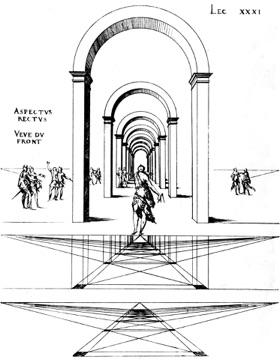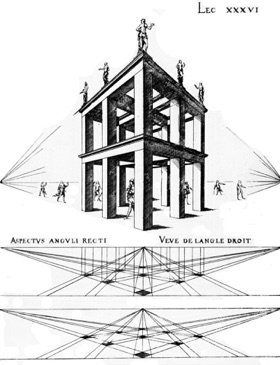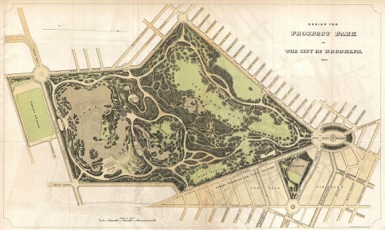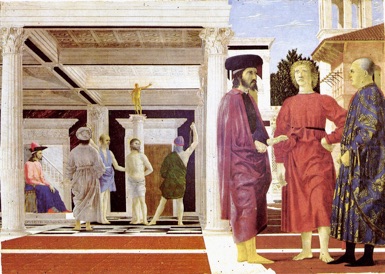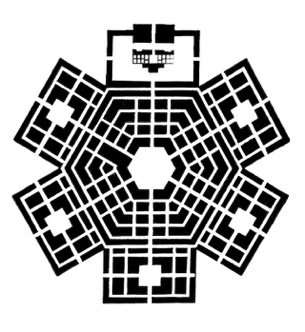

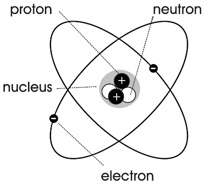
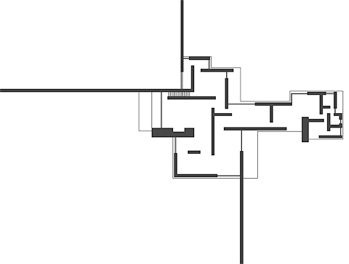
Box 4: A Brief History of Space
Page 21
Box 4: A Brief History of Space
Page 22
Box 4: A Brief History of Space
Page 23
Space, as positive form, was first invented and developed by the Romans. Three-dimensional deep architectural space emerged as a natural consequence of the inherent plasticity of brick and concrete vaulted construction. Two-dimensional painted illusions of deep space evolved to enliven the extensive wall surfaces (B4-a,b).
This concept of man-made constructed space could not have existed before Rome because Greek Architecture’s columned porticos were not meant to contain or define it. Greek space could not be articulated by man: it was the irresolute philosophical void, the mere interval between things, between man’s architecture, the gods, and landscape. It was not a medium of design, but rather the immutable continuity of nature (B4-c).
The Roman invention of space as a medium of design, molded by bounding walls and covered by arching vaults was perhaps the most important contribution to the whole innovative development of Western Architecture.
Only an Architecture of walls and spatial volumes had the inherent capacity for attachments and connections that allowed multiple forms to be joined together into complex patterns and extended sequences.
The concept of man-made space was integral to the development of architecture, but it was not identified as a discrete categorical term, until 1000 years after Rome with the Renaissance discovery of linear perspective by Brunelleschi in 1415. Perspective defined space itself because it provided a constructive framework for location, direction, and order through a complete geometric system of reference (B4-d).
Linear perspective was both a representational device and a method of craft. It incorporated a unified concept of design, integrating painting, architecture, and the structure of society and religion to embrace the complete image of Renaissance man and Humanism. The station point, symbolized the individual and his virtuosity in an ideal preferred view and location.
The vanishing point symbolized the centrality of man in general, focusing on the unified origins of form generating back to the human eye. Perspective thus combined in its concept of space both the principles of an underlying geometric order and the framework of its appearance to the individual (B4-e,f).
It was a codification however, that came with a built-in dichotomy because it was possible to see two versions of space implied by the viewpoints chosen within this construction. A one-point perspective emphasizes the surfaces and boundaries of interior shaped deep volume, (Space) but a two-point perspective emphasizes the object in an unbound, open exterior void (Anti-Space).
Both space and anti-space therefore, can be described by perspective, so that either one has the potential to dominate, depending on the prevailing world view.
Historically then, the form of space has been linked to the contemporary understandings of nature, of science, and of cosmology, as well as reflecting the philosophical and religious views governing at the time. The concept of aesthetic space is a cultural representation that describes both man’s place in the perceivable world, but also reflects his idea for the larger structure of the universe.
The designed form of space changes to correspond with these ideas, beginning with the finite solar system, contained within the static outer sphere of fixed stars in the Renaissance (B4-g), to the unconfined, dynamic, expanding infinite universe of the modern era. The result is a historical shift in awareness from finite to infinite, from static center to moving periphery, from wholeness of myth to a breakdown between scientific cosmological knowledge and our daily experience. From space to anti-space.
This historical relationship shows how today’s Anti-Space, can dominate architecture and urban design by default, because it is implicitly justified by the present state of scientific knowledge. The emptiness of Anti-Space fits nicely with current theories of physics and cosmology, because empty space is known to make up 99% of everything. Science tells us that it is all a void in flux from inside the atoms of “solid” mass to the outer vastness of an infinitely expanding universe (B4-h,i).
The question is, since it is no longer really possible to conceive of any human-scaled Space that could represent or correspond with the incomprehensible esoteric reality of scientific knowledge, why not make Space anyway, as pure architectural intention. We already know what it is. It is not lost or invalidated. And, we still live in a world of Euclidean geometry that is not determined by historicism.
Nature Discovered and Space Abandoned
The history of Anti-space not only reflects the current models of modern science, but also correlates with the romantic/modern idealization of Nature as a sacred refuge, a concept discovered in the early 18th century and institutionalized in 1970 with the establishment of the Environmental Protection Agency, whose purpose was to guard and maintain this Nature.
The suggestive illustrations on this page document and compare the historical transformations to each of the three man-made environmental constructs of place: the garden, the city, and architecture have all been handicapped by what Mies called “the abandonment of space”.
Plan of Small Bath at Hadrian’s Villa illustrates the elaborate flexibility of Roman space.
Wall painting illustrates two- dimensional deep space, Pompeii.
Plan of the Acropolis, Athens, the Propylaea filters, but does not enclose, the spatial continuity of nature.
Piero della Francesca’s Flagellation, 1455, One-point perspective orders and defines layered space.
Going From Foreground to Background
Space of the Solar System, the five Platonic bodies shown within the immobile sphere of the fixed stars, Kepler, 1596.
Anti-space at the cosmological scale, a view of clustered galaxies floating in the empty void of outer space. The infinite expanding universe was first revealed by Edwin Hubble, 1926, suggesting that, a universal void links the cosmological and atomic scales.
Two-point perspective: emphasizing the object in an unenclosed space.
One-point perspective: man’s preferred position at the center of closed space.
Anti-space at the atomic scale, diagram of the empty atom as a “planetary model” according to Rutherford, 1911.
The Three Places of Man
GARDEN
ARCHITECTURE
CITY
-
The Garden of SPACE
-
Perspective view of the Gardens at Villa d’Este, Tivoli, by Piero Ligorio, 1560-1575.
A Renaissance garden was like a book: a gridded space of paths in which to read an iconography of historical and mythical references. It focused on the relationship between Nature and Art.
The Architecture of SPACE
Byzantine Plan of San Vitale, Ravenna, Italy, 547.
-
The City of SPACE
-
Plan of the Hexagonal City of Grammichele, Sicily, 1693.
Built following the earthquake of the same year, it exists today, and epitomizes the Ideal City of Urban Space (and without fortified walls).
-
The Park of ANTI-SPACE
-
Plan of Prospect Park, Olmsted and Vaux, 1867-1873.
The Park was disconnected from the surrounding city, kept as a preserved piece of “landscape” with picturesque wild meadows, wooded ravines, and a meandering lake. Olmsted believed that natural landscapes were a necessary antidote to the confines of city life. It focused on the relationship between the Individual and Nature.
-
The Architecture of ANTI-SPACE
-
Plan of Mies’ Brick Country House, 1924.
Mies’ goal was "to bring Nature, houses and people into a higher unity….In the ground plan of this house, I have abandoned the usual concept of enclosed rooms and striven for a series of spatial effects rather than a row of individual rooms. The wall loses its enclosing character and serves only to articulate the house organism.”
-
The City of ANTI-SPACE
-
Plan of Salt Lake City, Utah, in 2010.
The Mormons’ Ideal City of Zion from 1848 is now a continuous graph paper grid of sprawl, crashing into hills. The streets are 130ft wide, the blocks 660ft square. Brigham Young hoped, that his new city of “Zion will extend, eventually, all over this earth.” (DBY, 120)
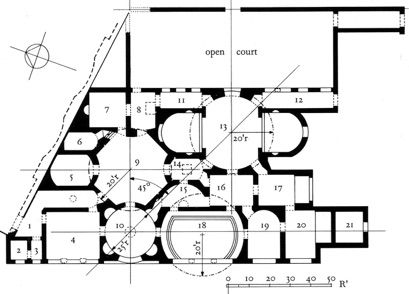
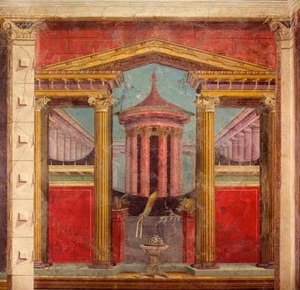
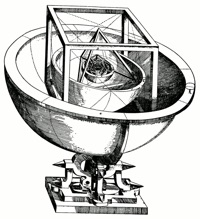



Click image for larger view
Click image for larger view
Click image for larger view






B4-a
B4-b
B4-c
B4-d
B4-e
B4-f
B4-g
B4-h
B4-i
B4-j
B4-k
B4-l
B4-m
B4-n
B4-o
